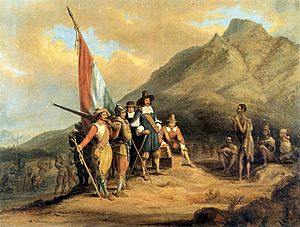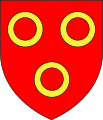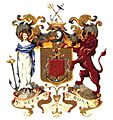Jan van Riebeeck facts for kids
Quick facts for kids
Jan van Riebeeck
|
|
|---|---|
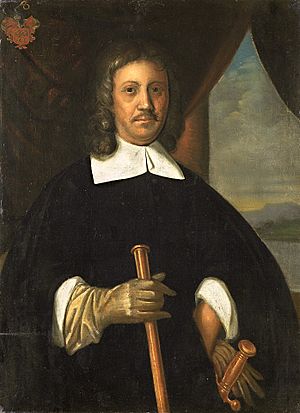 |
|
| 1st Commander of the Cape | |
| In office 7 April 1652 – 6 May 1662 |
|
| Succeeded by | Zacharias Wagenaer |
| Personal details | |
| Born |
Johan Petros Anthoniszoon van Riebeeck
21 April 1619 Culemborg, Duchy of Culemborg, Holy Roman Empire |
| Died | 18 January 1677 (aged 57) Batavia, Dutch East Indies |
| Resting place | Groote Kerk, Jakarta, Indonesia |
| Nationality | Dutch |
| Spouses | Maria de la Queillerie Maria Isaacks Scipio |
| Children | Abraham van Riebeeck 7 others |
| Occupation | Colonial administrator |
Jan van Riebeeck (born 21 April 1619 – died 18 January 1677) was a Dutch explorer and leader. He worked for the Dutch East India Company, which was a big trading company. He is famous for starting the first European settlement in what is now South Africa.
Contents
Jan van Riebeeck's Life Story
Early Years and Family
Jan van Riebeeck was born in a town called Culemborg in the Netherlands. His father was a surgeon. Jan grew up in Schiedam. In 1649, he married Maria de la Queillerie. She was 19 years old.
Jan and Maria had eight or nine children. Sadly, most of them did not live past infancy. Their son, Abraham van Riebeeck, was born in the Cape. He later became a very important leader in the Dutch East Indies.
Working for the Dutch East India Company
Jan van Riebeeck started working for the Vereenigde Oost-Indische Compagnie (VOC) in 1639. This company is known in English as the Dutch East India Company. He worked in many different roles. One of his jobs was as an assistant surgeon in Batavia, which is now Jakarta, Indonesia.
He also led a VOC trading post in Tonkin, which is in Vietnam. In 1645, he was fired from this job. This was because he was trading for his own profit.
Idea for a Refreshment Station
After being fired, Jan van Riebeeck sailed back home. On his journey, he stopped at the Cape of Good Hope for 18 days. He saw that it would be a good place for ships to stop. He thought it could be a "refreshment station." This meant ships could get fresh food and water there.
Two years later, a VOC ship got stuck at the Cape. The sailors built a temporary fort and survived. This made the company leaders, called the Heeren XVII, more interested in Jan's idea. They asked for a report that suggested the Dutch should have a presence at the Cape.
In 1643, Jan van Riebeeck even traveled to Dejima, a Dutch trading post in Japan. Later, in 1650, he suggested selling animal hides from South Africa to Japan.
Journey to the Cape
The Dutch East India Company asked Jan van Riebeeck to lead the first Dutch settlement in South Africa. He left the Netherlands on 24 December 1651. He sailed with 82 men and 8 women, including his wife Maria.
On 6 April 1652, two of his ships, the Drommedaris and Goede Hoope, arrived in Table Bay. This is where Cape Town is today. A third ship, the Reijger, arrived the next day. Two other ships arrived later.
Building a Supply Station
Jan van Riebeeck immediately started building a fort. The main goal was to create a stop for VOC ships. These ships sailed between the Netherlands and Batavia. Many sailors died on these long journeys. The stop at the Cape would provide fresh food and water. This would help keep the sailors healthy.
Commander of the Cape Settlement
Jan van Riebeeck was the Commander of the Cape from 1652 to 1662. His job was to build a fort and make the harbor better. He also had to plant crops like grains, fruits, and vegetables. Another important task was to get livestock, like cows and sheep, from the local Khoi people.
Changes to the Environment
At the Kirstenbosch National Botanical Garden in Cape Town, you can still see some wild almond trees. These trees were part of the natural environment when Jan van Riebeeck arrived.
The first fort he built was called Fort de Goede Hoop (Fort of Good Hope). It was made of mud, clay, and wood. It had four corners, like a star. This fort was later replaced by the Castle of Good Hope. The Castle was built between 1666 and 1679, after van Riebeeck had left.
A friend from his hometown, Roelof de Man, joined van Riebeeck at the Cape. Roelof arrived in 1654. He worked as the colony's bookkeeper and later became second-in-command.
Growing Food and Observing Nature
Jan van Riebeeck was very active in planting useful plants at the Cape. He brought in grapes, grains, potatoes, apples, and citrus fruits. These plants changed the natural environment forever. They also had a big impact on the people and economy of the region. For example, in 1659, he started a vineyard to make red wine. This wine was meant to help fight scurvy, a disease sailors often got.
He kept a daily diary during his time at the Cape. This was a rule of the VOC. His diaries helped people later on to learn about the natural environment and its resources. His writings show that he also learned a lot from the local people living there.
Jan van Riebeeck died in Batavia (now Jakarta) in 1677.
Jan van Riebeeck's Legacy in South Africa
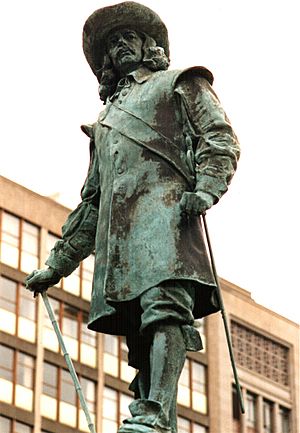
Jan van Riebeeck is a very important historical figure in South Africa. For many Afrikaners, he is seen as the person who started their nation.
His image was often seen on stamps and banknotes in South Africa until 1994. After South Africa became a republic in 1961, an image used on money was thought to be van Riebeeck. However, it was actually a painting of someone else named Bartholomeus Vermuyden.
Holidays and Monuments
April 6th used to be a public holiday in South Africa. It was called van Riebeeck's Day, and later Founders' Day. But this holiday was stopped by the government after the 1994 elections.
You won't see his image on official money or stamps anymore. But statues of him and his wife are still in Adderley Street in Cape Town. The coat of arms for the city of Cape Town is based on the van Riebeeck family's own coat of arms.
Many towns and villages in South Africa have streets named after him. Riebeek-Kasteel is one of the oldest towns in South Africa. It is about 75 km from Cape Town. It is in the Riebeek Valley, along with its sister town Riebeek West.
Hoërskool Jan van Riebeeck is an Afrikaans high school in Cape Town.
Images for kids
See also
 In Spanish: Jan van Riebeeck para niños
In Spanish: Jan van Riebeeck para niños
- Hoërskool Jan van Riebeeck
- Dutch East India Company
- Cape of Good Hope
- Dutch Cape Colony


